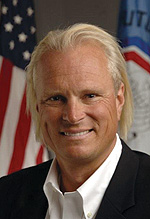Energy and Environmental Markets Advisory Committee – Commissioner Chilton
 “Energy markets have a huge impact on our economy and consumers. All of us can remember $147 a barrel oil and $4.00 gas. While environmental markets are in a more fledgling stage, I believe they will become more and more prominent as the world faces pollution and population issues and as emissions trading becomes more pronounced.”
“Energy markets have a huge impact on our economy and consumers. All of us can remember $147 a barrel oil and $4.00 gas. While environmental markets are in a more fledgling stage, I believe they will become more and more prominent as the world faces pollution and population issues and as emissions trading becomes more pronounced.”The Energy and Environmental Markets Advisory Committee (formerly the Energy Markets Advisory Committee) was created in 2008 to advise the Commission on important new developments in energy and environmental futures markets that may raise new regulatory issues, and the appropriate regulatory response to ensure market integrity and competition, and protect consumers.
“Energy markets have a huge impact on our economy and consumers. All of us can remember $147 a barrel oil and $4.00 gas. While environmental markets are in a more fledgling stage, I believe they will become more and more prominent as the world faces pollution and population issues and as emissions trading becomes more pronounced,” said Commissioner Chilton.
“The goal of the EEMAC has been to bring together a wide variety of experts to look in detail at why these markets behave the way they do. The committee has explored proposals for position limits, hedge exemptions, carbon trading, the affect of price volatility on consumers and regulatory reform among other issues.”
CFTC Commissioner Bart Chilton chaired the Energy and Environmental Markets Advisory Committee. Members included industry professionals, representatives of futures exchanges, market participants, academics, consumer advocates, and environmental organizations.
Bart Chilton, Commissioner

Bart Chilton was nominated by President Bush and confirmed by the U.S. Senate in 2007. In 2009, he was nominated by President Obama and reconfirmed by the U.S. Senate. His career spans 25 years in government service—working on Capitol Hill in the House of Representatives and in the Senate, and serving the Executive Branch during the Clinton, Bush, and Obama Administrations.
Prior to joining the CFTC, Mr. Chilton was the Chief of Staff and Vice President for Government Relations at the National Farmers Union where he represented average family farmers. In 2005, Mr. Chilton was a Schedule C political appointee of President Bush at the U.S. Farm Credit Administration where he served as an Executive Assistant to the Board. From 2001 to 2005, Mr. Chilton was a Senior Advisor to Senator Tom Daschle, the Democrat Leader of the United States Senate, where he worked on myriad issues including, but not limited to, agriculture and transportation policy.
From 1995 to 2001, Mr. Chilton was a Schedule C political appointee of President Clinton where he rose to Deputy Chief of Staff to the U.S. Secretary of Agriculture Dan Glickman. In this role, Mr. Chilton became a member of the Senior Executive Service (SES)—government executives selected for their leadership qualifications to serve in the key positions just below the most senior Presidential appointees. As an SES member, Mr. Chilton served as a liaison between Secretary Glickman and the Federal work force at USDA.
From 1985 to 1995, Mr. Chilton worked in the U.S. House of Representatives where he served as Legislative Director for three different Members of Congress on Capitol Hill and as the Executive Director of the bipartisan Congressional Rural Caucus.
Mr. Chilton previously served on the Boards of Directors of Bion Environmental Technologies and the Association of Family Farms.
Mr. Chilton was born in Delaware and spent his youth in Indiana, where he attended Purdue University (1979–1982). He studied political science and communications and was a collegiate leader of several organizations.



